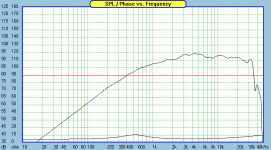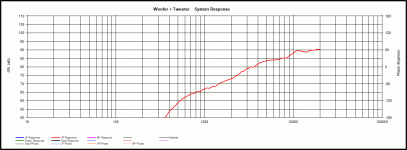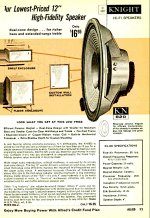Seas Flagship Crescendo states 92db sens.
I bought a single off ebay and was actually not more than 82db sens, IF THAT.
So you measured it? Is it this one: SEAS Excel T29CF-002 (E0040) Crescendo Fabric Dome Tweeter
jeff
Next yr I'd like for someone to snag a pair of DLVX8's and stagea shootout with any Fostex higher end models..
See how it goes.
Particularly human vocals, /full orchestra.
Bass , highs not interested.
Just those critical mids.
As I say any xover low sens speaker can make bass/highs, Big deal. Evena Bose ora B&W can make bass and highs..
But mids?
xover types fall sour.
Paper cone woofers, yuck.
See how it goes.
Particularly human vocals, /full orchestra.
Bass , highs not interested.
Just those critical mids.
As I say any xover low sens speaker can make bass/highs, Big deal. Evena Bose ora B&W can make bass and highs..
But mids?
xover types fall sour.
Paper cone woofers, yuck.
yeah thats the Big Lie
I brought it to my amp guy's repair shop,, He put it on his small gadget taht only makes a beep at certain fq's like ,,something like that,, and the beep was low, very low,,,I thought,,**whaaaa the hoooot**
so got home, hooked her up to0a cap, I think 2.2 Mundorf SESGO,,,and could BARELY hear the thing..
No the Ebay seller did not sell mea bad tweeter.
Its was like new in box UNUSED..
Its off bya factor of 10db, maybe more.
The Millennium is 87db, and completely annihilates the NEW flagship.
I sold it for 100 on eaby free ship.
and i 've heard the Bifrost YT vid 50 times,,, now I get the fact that speaker isa bit warm,, the tweeter is muted, its unaudible, No s heen due to its extreme inefficient nature.
Also considering there's not much in snare drums in classical, violins up to 7k hz range,,a tweeter is aonly for sheen and ambience.
........and why I either EQ'd the wide range or if using a [super] tweeter just capped them off really high [20-40 kHz] and of course level matched if efficiencies were audibly off.
Regarding the Seas Crescendo tweeter, it is not a 'NEW flagship'. It was introduced in 2007, and has the Exotic T35, T29B001 beryllium dome and T29D001 / T29D002 diamond dome tweeters above it in their range. The short-lived magnesium dome Magnum was also somewhat above the Crescendo in the Seas range.
As for the 'extreme inefficient nature' -two independent measurements of Crescendo tweeters attached. The first is from Zaph, measured in 2007. The second is from HifiCompass, measured last year. Almost identical, give or take about 1/2 a decibel, and hovering around the claimed 92.5dB 1m/2.83v rating. However, the Crescendo has had, as I understand, some production QC / QA issues, so it is certainly not beyond the bounds of possibility that a bad one was received from the eBay seller. However, a more likely cause for the lack of output can be found fairly easily. Also attached is the FR of the Crescendo (I've not bothered simulating baffle effects as it doesn't matter for this case) with the 2.2uF series capacitor stated above (red line). In effect, 12dB down at 3KHz, 18dB down at 2KHz, and that's just by itself, and ignoring the potential for destructive interference in the HF, improper level matching / system design etc. which on current evidence is highly likely. 😉
As for the 'extreme inefficient nature' -two independent measurements of Crescendo tweeters attached. The first is from Zaph, measured in 2007. The second is from HifiCompass, measured last year. Almost identical, give or take about 1/2 a decibel, and hovering around the claimed 92.5dB 1m/2.83v rating. However, the Crescendo has had, as I understand, some production QC / QA issues, so it is certainly not beyond the bounds of possibility that a bad one was received from the eBay seller. However, a more likely cause for the lack of output can be found fairly easily. Also attached is the FR of the Crescendo (I've not bothered simulating baffle effects as it doesn't matter for this case) with the 2.2uF series capacitor stated above (red line). In effect, 12dB down at 3KHz, 18dB down at 2KHz, and that's just by itself, and ignoring the potential for destructive interference in the HF, improper level matching / system design etc. which on current evidence is highly likely. 😉
Attachments
Last edited:
Very good research, you have helped solved **The Crescendo low sens mystery ofa single driver**
I should have immediaetly senta message to the Ebay seller stating what issues I have with his single driver.
But like me, I don't think through things methodically.
I am compulsive and lose track of rational thinking proscess.
Cant recall if ad said No Returns... But I did just write the seller letting his know although he shows a pic of the ohms 7 ohms,, he did not test for sensitivity,,,,But why would he,, why would I ever imagine that ~~~SEAS~~~~ Worlds finest manufacturer of speakers,, even allow a bad tweeter to pass inspection
😕😕😕😕😕
This is why I made poor decisions not writing back to the seller. I trusted 100% in Seas quality control.
It really isa mystery.
Seas would never ever allow a super low sens tweeter to pass through their doors, Never ever.
But apparently they did just that.
I asked seller just now, why a single for sale,,, that alone was a big red flag.
Stupid me.
OK so now we know the Crescendo is a **Super Millennium*** after all.
But now its too, late..
I can geta pair of DavidLouis Be/Nd tweeters for $300 includes shipping, vs Seas/Scan speaker Be/Nd for $$$$$$$$$$$$$
No thanks.
+ I bet the Davidlouis/92db sens equals in performance the Crescendo/92db tweeter.
But we will never know for sure.
I should have immediaetly senta message to the Ebay seller stating what issues I have with his single driver.
But like me, I don't think through things methodically.
I am compulsive and lose track of rational thinking proscess.
Cant recall if ad said No Returns... But I did just write the seller letting his know although he shows a pic of the ohms 7 ohms,, he did not test for sensitivity,,,,But why would he,, why would I ever imagine that ~~~SEAS~~~~ Worlds finest manufacturer of speakers,, even allow a bad tweeter to pass inspection
😕😕😕😕😕
This is why I made poor decisions not writing back to the seller. I trusted 100% in Seas quality control.
It really isa mystery.
Seas would never ever allow a super low sens tweeter to pass through their doors, Never ever.
But apparently they did just that.
I asked seller just now, why a single for sale,,, that alone was a big red flag.
Stupid me.
OK so now we know the Crescendo is a **Super Millennium*** after all.
But now its too, late..
I can geta pair of DavidLouis Be/Nd tweeters for $300 includes shipping, vs Seas/Scan speaker Be/Nd for $$$$$$$$$$$$$
No thanks.
+ I bet the Davidlouis/92db sens equals in performance the Crescendo/92db tweeter.
But we will never know for sure.
This mystery is now solved.
We know fora fact Seas alolowed a bad tweeter to pass through its very doors.
Which only goes to show a once magestic impecable speaker manufacturer has now gone the way of all things in this modern world,
Decay.
Slow but sure ~Decay~~ Rot, breakdown, Meltdown.
We know fora fact Seas alolowed a bad tweeter to pass through its very doors.
Which only goes to show a once magestic impecable speaker manufacturer has now gone the way of all things in this modern world,
Decay.
Slow but sure ~Decay~~ Rot, breakdown, Meltdown.
No, you don't 'know that for a fact' or anything even approaching such. I simply noted that it was a possibility. It might be true. It might not. These things can happen from time to time, since no manufacturing process is flawless and errors do occasionally happen. It is a trifle excessive then to announce, based on pure speculation, that Seas is in 'decay', 'rot[ting', in 'breakdown' or 'meltdown.' Especially since you claim to have purchased a single example from a random eBay seller, not an officially recognised distributor or retailer, so you have zero knowledge of its provenance.
Equally, if you just chucked the thing into the system with a single 2.2uF capacitor, then its output will be rapidly falling off below 10KHz and around 18dB down by 2KHz, so by definition you wouldn't hear a whole lot of output from it. If you then compound that by poor system design causing destructive interference (i.e. losses) above 10KHz, which is quite on the cards, you wouldn't have much usable output up there either.
Equally, if you just chucked the thing into the system with a single 2.2uF capacitor, then its output will be rapidly falling off below 10KHz and around 18dB down by 2KHz, so by definition you wouldn't hear a whole lot of output from it. If you then compound that by poor system design causing destructive interference (i.e. losses) above 10KHz, which is quite on the cards, you wouldn't have much usable output up there either.
Last edited:
WEll I was only going on my tech mentioned.
Thata well designed xover is not going to increase sensitivity level.
Which makes alot of sense to me.
Then maybe I should hold off on the Davidlouis Be/Nd tweeter, as all I intend is to placea 6uf cap, 1st order.. Which again may not be the correct xover thus resulting in issues/breakups and such.
Yes?
You know I just cked another YT vid on the Crescendo,
Seems my hunch is wrong.
I can clearly hear some gorgeous highs.
,,, Aplogies to Seas.
But again, we are not 100% sure.
Might be defective, then again might not.
What I will need is a xover for the Davidlouis Be/Nd.
Do you know of anyone that can help me in this regard?
DIY SEAS BIFROST & DIY TUBE IC AMP Ⅱ (Ultra High End♪) - YouTube
Thata well designed xover is not going to increase sensitivity level.
Which makes alot of sense to me.
Then maybe I should hold off on the Davidlouis Be/Nd tweeter, as all I intend is to placea 6uf cap, 1st order.. Which again may not be the correct xover thus resulting in issues/breakups and such.
Yes?
You know I just cked another YT vid on the Crescendo,
Seems my hunch is wrong.
I can clearly hear some gorgeous highs.
,,, Aplogies to Seas.
But again, we are not 100% sure.
Might be defective, then again might not.
What I will need is a xover for the Davidlouis Be/Nd.
Do you know of anyone that can help me in this regard?
DIY SEAS BIFROST & DIY TUBE IC AMP Ⅱ (Ultra High End♪) - YouTube
Last edited:
No passive crossover can add output, with the exception of very high Q bandpass circuits which are quite rare and of very limited use. However, if you start rolling the tweeter off at a very high frequency, by definition, you don't have much useful output below that.
As for a crossover design for your DavidLouis / MeloLouis / whatever-they-call-themselves-on-this-day-in-history drivers, as your 'tech' will tell you, you will need to measure the frequency and impedance responses (including phase) of all the drivers in the intended baffle, which can then be used to design the filter.
As for a crossover design for your DavidLouis / MeloLouis / whatever-they-call-themselves-on-this-day-in-history drivers, as your 'tech' will tell you, you will need to measure the frequency and impedance responses (including phase) of all the drivers in the intended baffle, which can then be used to design the filter.
So you read through page after page of a thread like this and Dave or Scott usually post some amazing link I've never heard of. Some interesting statements in that "Basszilla" article, which I read at Tip_49
The amplifier driving the design there has an output impedance of (drum roll...) 80 Ohms.
There's a way to achieve that from a "normal" amp, but it's unconventional. With a 100W amp going into it, you might get the same 10W capability as the ($2500) F1 cited in the article. Perhaps there's a different Xover design for low-Z output amps, for these drivers as mounted / baffled.
I'm playing with Hi-Z drive and recently spent *$50* (oooh!) on a set of vintage 30W matching transformers off ebay. I once called one of the transformer manufacturers still in business who said yeah, they could do it - for a $100-$200 design fee upfront. Not bad if it would allow using an ordinary amplifier with the claimed advantages of the Hi-Z drive / crossover design cited in the linked article...
The amplifier driving the design there has an output impedance of (drum roll...) 80 Ohms.
There's a way to achieve that from a "normal" amp, but it's unconventional. With a 100W amp going into it, you might get the same 10W capability as the ($2500) F1 cited in the article. Perhaps there's a different Xover design for low-Z output amps, for these drivers as mounted / baffled.
I'm playing with Hi-Z drive and recently spent *$50* (oooh!) on a set of vintage 30W matching transformers off ebay. I once called one of the transformer manufacturers still in business who said yeah, they could do it - for a $100-$200 design fee upfront. Not bad if it would allow using an ordinary amplifier with the claimed advantages of the Hi-Z drive / crossover design cited in the linked article...
Last edited:
Aye, that's a custom version of Basszilla Dick created for high output impedance amplifiers like the F1. The 'regular' Platinum etc. versions assume conventional voltage source designs.
You can ~mimic the effect with a power-resistor in series with a regular voltage source; inefficient of course as you're burning up power in the resistors, & it generates significant heat, but can be effective providing you go into it knowing exactly what you're doing and why.
You can ~mimic the effect with a power-resistor in series with a regular voltage source; inefficient of course as you're burning up power in the resistors, & it generates significant heat, but can be effective providing you go into it knowing exactly what you're doing and why.
Joe, do you have a link to your transformer project thread?
Interesting topic, maybe for another thread.No passive crossover can add output,
Hi AllenB, I got the idea here. Clean-current speaker project | Current-Drive - The Natural Way of Loudspeaker Operation
My effort differs in that I use a Line matching transformer, originally intended to convert a Hi-Z drive into a 4, 8, 16 Ohm speaker drive. I run it backwards. Also I use none of the passive circuitry, save the resistor on the "primary", as I have the cross done in DSP.
My effort differs in that I use a Line matching transformer, originally intended to convert a Hi-Z drive into a 4, 8, 16 Ohm speaker drive. I run it backwards. Also I use none of the passive circuitry, save the resistor on the "primary", as I have the cross done in DSP.
I think the last time I saw anything akin to that, it was an old W.E. circuit (sans the DSP, naturally). I like it. 🙂
when using an amplifier with`"~constant voltage" characteristics,
a passive highpass network sometimes can be configured to add "gain"over a limited region by having a dip in input impedance.thus pulling more power
When using a transformer or autoformer *with a network. wideband gain can had the cost of a lower reflected impedance to the amplifier (and more power drawn) (^PWK used an aotoformer in a patent associated with hisLB6 speaker)
When I was first dabbling in hifi it was common with the typical fullrange drivers of that day to see specs for their "mechanical crossover", where the whizzer cone or inner decoupled area of the cone rolled into action.
FWIW I remember this 1963 Allied catalog's cover well.
a passive highpass network sometimes can be configured to add "gain"over a limited region by having a dip in input impedance.thus pulling more power
When using a transformer or autoformer *with a network. wideband gain can had the cost of a lower reflected impedance to the amplifier (and more power drawn) (^PWK used an aotoformer in a patent associated with hisLB6 speaker)
When I was first dabbling in hifi it was common with the typical fullrange drivers of that day to see specs for their "mechanical crossover", where the whizzer cone or inner decoupled area of the cone rolled into action.
FWIW I remember this 1963 Allied catalog's cover well.
Attachments
Also considering there's not much in snare drums in classical, violins up to 7k hz range,,a tweeter is aonly for sheen and ambience.
I'm listening to classical and now tghats its pulled, I really don't miss it.
The Davidlouis (aka David Melo) has pretty good timber in highs.
A loudspeaker that only sounds good on some particular kinds of music is not a good loudspeaker by definition.
A good loudspeakers makes anything you play at it at least interesting to listen to, even if, or should I say especially, it is not your preferred genre. At the moment you'll notice yourslef skipping music because something get's on your nerves/doesn't sound right/doesn't sound interesting than you know there is something flawed about the system. I have heard many fullrange drivers over the years and I even use fullrange drivers as midrange in my own system but I haven't come across one that was satifying from the very bottom to the top end. There is always a compromise either in low frequency "gestalt' or in treble extension and most of all in-room power response.
And yes, I have heard the Melo David VX8 and while it is a nice driver it also does not break the law of physics. Use is standalone and you'll end up with a system that sounds good on certain recordings but quite bad on certain other recordings. Most people start blaming the recording then or even say that the loudspeaker is sooo good it makes bad recording even sound worse instead of looking at the flaws in the playback system. In 90% of the cases it wasn't the recording to blame.
Personally I would use it as midrange from around 80-100Hz to 3-4 kHz, maybe higher but totally dependant on the matching tweeter. Pair it with some good 15" woofers and some matched tweeters (as in directivity and dynamics) and you'll have a system that can play anything with ease.
That will do it. Very DIY of you 😉My effort differs in that I use a Line matching transformer, originally intended to convert a Hi-Z drive into a 4, 8, 16 Ohm speaker drive. I run it backwards.
A loudspeaker that only sounds good on some particular kinds of music is not a good loudspeaker by definition.
A good loudspeakers makes anything you play at it at least interesting to listen to, even if, or should I say especially, it is not your preferred genre. At the moment you'll notice yourslef skipping music because something get's on your nerves/doesn't sound right/doesn't sound interesting than you know there is something flawed about the system. I have heard many fullrange drivers over the years and I even use fullrange drivers as midrange in my own system but I haven't come across one that was satifying from the very bottom to the top end.
***from bottom to top end**
I am not looking fora 10hz-50khz FR speaker single stand alone.
AER and Voxativ claims their FR goes to 10hz - 50khz, There ya go, grab it, as Be All End All FR....
Now on to more realistic discussion.
The DLVX8 has bass, where to, not sure.
Its there
Highs, meets my criterion.
From your comments I can see you are not at all impressed with the DLVX8.
**its all right...**
😕😱
- Home
- Loudspeakers
- Full Range
- DavidLouis VX8 wide band



